Costa Rica's
National Symbols
We present some of the official Symbols of Costa Rica.
Costa Rica's Flag and Banner
The Fist Lady, Pacífica Fernández Oreamuno, designed the flag of Costa Rica in 1848.
The flag was designed after the ideals of the French Revolution - freedom, equality, and brotherhood - and the colors of the French National Flag.
The flag of Costa Rica consists of five horizontal stripes: A red stripe located in the center,
between two white stripes, which are between two blue stripes. The width of each stripe is 1/6 of the total width of the flag,
except the red stripe, which is 2/6 of the total width.
Each color represents important aspects of Costa Rica:
Blue means the sky, opportunities at reach, intellectual thinking, perseverance to accomplish a goal, infinite, eternity, and ideals of the religious and spiritual desires.
White means clear thinking, happiness, wisdom, power and beauty of the sky, the driving force of initiatives to search for new endeavors, and the peace of Costa Rica.
Red means the warmth of Costa Rican people, their love to live, their blood shed for freedom, and their generous attitude.
Flag in Castilian Spanish has two meanings: "Bandera" and "Pabellón Nacional."
The first one refers to a national flag. The second one refers to a national flag with the national
shield printed on the center of the red stripe. Most High Schools and Primary schools, public offices, government offices,
foreign missions and merchant ships must have the "Pabellón Nacional." For parties or civil activities people use the "Bandera."
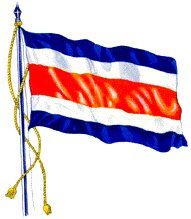
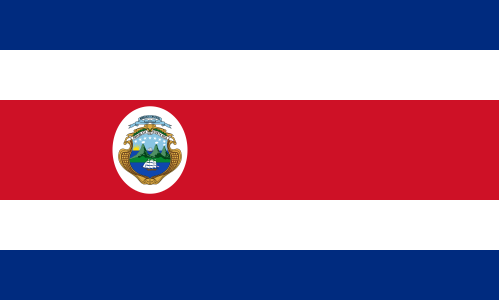
Costa Rica's National Shield / Emblem
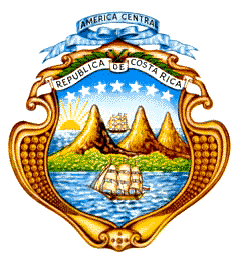
Costa Rica's National Shield was created in 1848.
The original seal went through two important changes. In 1906, war symbols were removed as a response to Costa Rican's tradition for peace. And in 1964,
two more stars were added to represent the newly incorporated provinces of Limón and Puntarenas (before they were regions).
"América Central" (Central America) is imprinted on the blue ribbon at the top of the coat of arms. The two branches of myrtle closing the coat of arms represent the peace of Costa Rica.
On the white ribbon that joins the branches, the title "República de Costa Rica" (Republic of Costa Rica). The seven stars above the volcanoes represent the seven
provinces of Costa Rica: Alajuela, Cartago, Guanacaste, Heredia, Limon, Puntarenas, and San José.
The hills represent Costa Rica's three mountain range systems. They form a valley and divide the country in two parts. The two oceans represent the Atlantic and Pacific oceans.
The merchant ships sailing on each ocean represent the cultural and commercial exchange between Costa Rica and the rest of the world. The rising sun represents the prosperity of Costa Rica.
The small circles on both sides of the coat represent the coffee beans, "Golden Beans."
Costa Rica's National Bird - Yiguirro
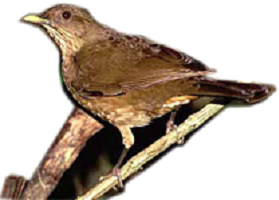
The "Yigüirro" (Turdus grayi), also known as the clay colored robin or gray thrush, was declared the National Bird on January 3rd 1977,
as a tribute to its powerful and melodious call that signals the beginning of the rainy season.
This bird was chosen especially because it is so familiar to Costa Ricans as it tends to live near people's homes.
The nesting season takes place between April and May. During this time, the "Yigüirro" does not sing and lays from two to three eggs.
The "Yigüirro," a friendly and peaceful bird, is not afraid of humans, however, it protects its brood
According to Costa Rican law, anyone who hunts, mistreats or holds this bird in captivity will be severely punished.
Costa Rica's National Tree - Guanacaste Tree
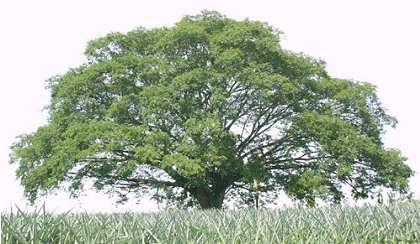
The "Guanacaste" (Enterolobium cyclocarpum), a native tree to Costa Rica, was designated the National Tree on
August 31, 1959.
It belongs to the leguminous family and the subfamily of the Mimosas. It is found along the coasts of Central
America as well as Cuba and in the lowlands of the Antilles.
It was chosen as a tribute to the people of Guanacaste, which was the last province to join the Republic in 1825.
With the giant shade it provides, this tree symbolizes the protection that Costa Ricans enjoy from the State.
The name "Guanacaste" originates from a native language called "náhuatl" and means "tree of the ears".
This is because the fruits of the tree are similar to the shape of the human ear.
The "Guanacaste" grows on lands at sea level and up to 900 m. (2,952 feet) Its height varies from 25 m. (82 feet) to 50 m. (164 feet) high.
The diameter of its trunk is usually 2 m (6.6 feet). It grows fast in low and sunny lands, especially in Guanacaste.
It has a robust trunk and a beautiful appearance. On Its thick long branches grow horizontally. The tree not only supports and takes root on the soil,
but also absorbs the surrounding soil forming bulky roots that spread around the surface.
Costa Rica's National Flower - Guaria Morada
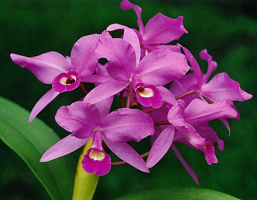
The "Guaria Morada" (Cattleya skinneri), is an orchid. It was designated the National Flower of Costa Rica on June 15, 1939.
The "Guaria Morada" grows on trees, roofs, and buildings. It gets nutrients from the air, rain, dust, and residues stored on the trunk of trees.
These plants use trees as a means of support, but they are not parasites.
Orchid flowers are large with fantastic shapes, amazing colors, and enchanting fragrances.
The most beautiful and numerous orchids are grown in tropical countries. They are an essential part of tradition and folklore.
There are nearly 15,000 species around the world, one of the plants with the largest variety in the world.
Costa Rica National Symbol - The Oxcart "La Carreta"
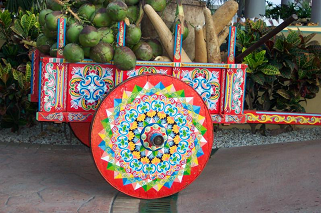
In 1988 the Costa Rican ox-cart ("la carreta costarricense") was established as the national symbol of work.
This decision was based on the contribution that the ox-cart has had throughout Costa Rican history in the economic and social development of the nation.
Drawn by a team of oxen, the ox-cart was used during the colonial period for the transportation of sugar cane, tobacco, and coffee.
Thus, it became a very important factor in the development of agricultural activity of Costa Rica.
The peasants used to paint the carts in very strong, bright colors with the two-fold purpose of making them look beautiful and preserving them.
Eventually, this evolved into a kind of competition among the owners of the different farms to see who had, not only the best team of oxen, but also the most beautiful carts in the area.
In the present, the ox-cart is one of the most representative handcrafted objects in Costa Rican culture. The traditional oxcart, or carreta,
is Costa Rica's most famous type of craft. From the mid-nineteenth century, oxcarts were used to transport coffee beans from Costa Rica's central valley over
the mountains to Puntarenas on the Pacific coast, a journey requiring ten to fifteen days. The oxcarts used spokeless wheels, a hybrid between the disc
used by the Aztec and the spoked wheel introduced by the Spanish, to cut through the mud without becoming bogged down. In many cases, oxcarts were a family's
only means of transport and often served as a symbol of social status.
The tradition of painting and decorating oxcarts started in the early twentieth century. Originally, each region of Costa Rica had its own particular design,
enabling the identification of the driver's origin by the painted patterns on the wheels. By the beginning of the twentieth century, flowers, faces and even miniature
landscapes appeared beside patterns of pointed stars. Annual contests were arranged to reward the most creative artists and are still held today.
Costa Rica's National Hero - Juan Santamaría
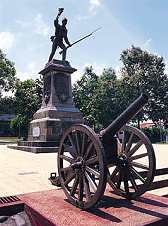
Juan Santamaría (August 29,1831 – April 11, 1856), is officially recognized as the national hero of the Republic of Costa Rica.
A national holiday in Costa Rica, Juan Santamaría Day, is held every April 11 to commemorate his death.
Santamaría was born in the city of Alajuela. When U.S. adventurer William Walker overthrew the government of Nicaragua and attempted
to conquer the other nations in Central America, including Costa Rica, in order to form a private slave-holding empire, Costa Rican president
Juan Rafael Mora Porras called upon the general population to take up arms and march north to Nicaragua to fight against the foreign invader.
Santamaría, a poor laborer and the illegitimate son of a single mother, joined the army as a drummer boy. The troops nicknamed him el erizo ("the hedgehog") on account of his spiked hair.
After routing a small contingent of Walker's soldiers at Santa Rosa, Guanacaste, the Costa Rican troops continued marching north and reached the city of Rivas, Nicaragua, on April 08, 1856.
Combat was fierce and the Costa Ricans were not able to drive Walker's men out of a hostel near the town center from which they commanded an advantageous firing position.
According to the traditional account, on April 11 Costa Rican General José María Cañas suggested that one of the soldiers advance towards the
hostel with a torch and set it on fire. Some soldiers tried and failed, but finally Santamaría volunteered on the condition that, in the event of his death, some other soldier would look after his mother.
He then advanced and was mortally wounded by enemy fire. Before expiring he succeeded, however, in setting fire to the hostel,
thus contributing decisively to the Costa Rican victory at Rivas. This account is apparently supported by a petition for a state pension filed on
November of 1857 by Santamaría's mother, as well as by government documents showing that the pension was granted. Various historians, however,
have questioned whether the account is accurate, and if Santamaria died or not during that battle or another one.
At any rate, towards the end of the 19th century Costa Rican intellectuals and politicians seized on the war against
Walker and on the figure of Juan Santamaría for nationalist purposes. Juan Santamaría is honored by a statue in the central square of Alajuela,
and by a small museum in the same city; as a side note, the statue's uniform and body don't match his description due to the fact that Juan's statue
was mis-shipped to Haiti, and the Haitian one, representing a French soldier, was sent to Alajuela. The main International airport in Costa Rica is named after him.
| 


